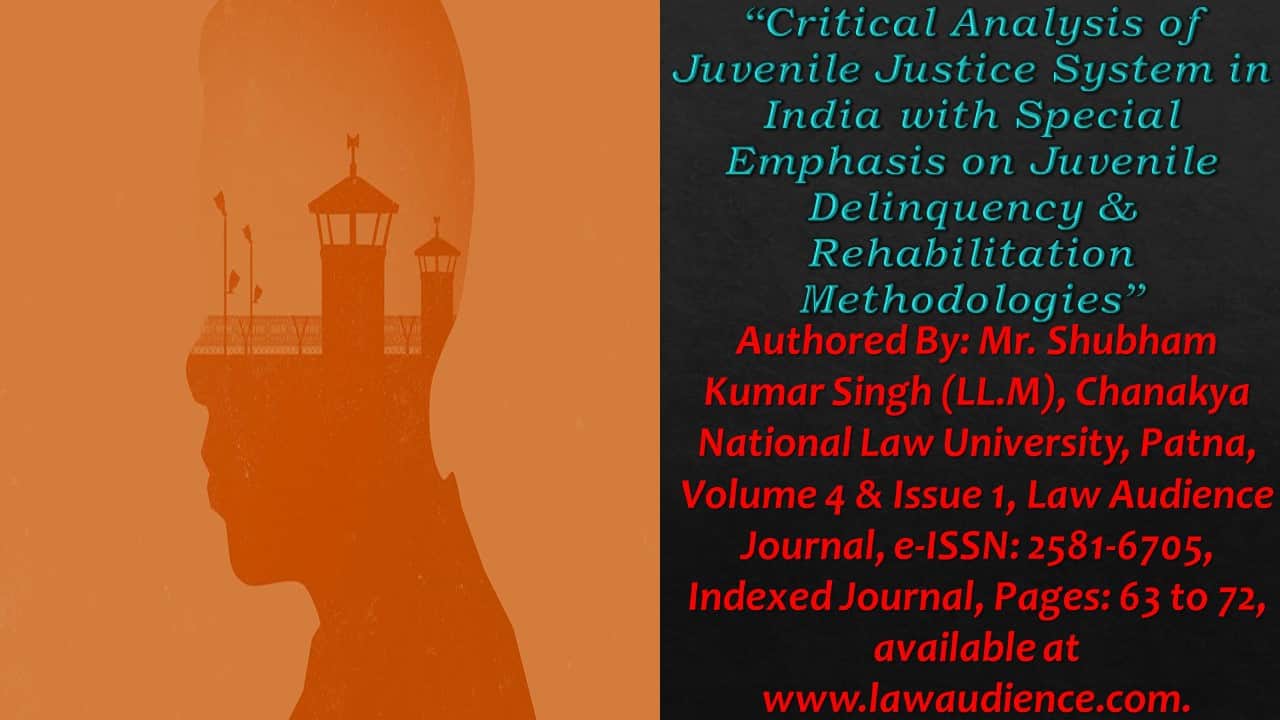Click here to download the full paper (PDF)
Authored By: Mr. Shubham Kumar Singh (LL.M), Chanakya National Law University, Patna,
Click here for Copyright Policy.
ABSTRACT:
“As, it is said children are the future of nations, they are one of the greatest assets of a nation. But sometimes because of immaturity, lack of awareness of the nature and consequences, poverty, psychological factors and various other social and peer factors. In the present essay, we will be starting with the juvenile delinquency, so as to get a fundamental background behind the reasons, why there has been an increasing trend of juveniles’ crime rate, further we will be discussing in brief about the Juvenile Justice System in India and about the relevant international conventions. After, that we will be focusing on best practices followed worldwide for juvenile rehabilitation in comparison to that of India. At, the end we will come up with recommendations in-order to enhance the rehabilitation methods under Indian Juvenile Justice System. The study will also refer to some relevant statistical data and case studies in order to substantiate the claims. Overall, the aim of this essay is to identify the current scenario of Indian Juvenile Justice System in terms of its Rehabilitation methodologies and whether it needs to be strengthened further for a holistic rehabilitation of the juveniles. As, the Indian Juvenile System has focused on rehabilitation instead of punishment, and whether those rehabilitation methodologies are efficient enough, or we need changes will be the main driving aim of this essay. We, do have problems everywhere but we should not let the problems to rules us, rather we should become the captain of the problems to solve them”.
Keywords: Juvenile, Delinquency, Rehabilitation, Best Practices.
I. Introduction:
“Darkness cannot drive out darkness; only light can do that. Hate cannot drive out hate; only love can do that.” – Martin Luther King, Jr.
The most important aspect of juvenile justice is whether to treat the juveniles with punishment or to provide for rehabilitation of the juvenile. As , we know the sentencing of an individual convicted of a criminal offence is mainly driven by three key considerations which are :retribution (punishment), deterrence and rehabilitation. In the case of juvenile offenders, the principle of rehabilitation is often assigned the greatest weight.[1] If we take a look into the history , in the ancient era the Roman law, provided the principle of “doli incapax” and protected young children from prosecution owing to the presumption of a lack of capacity and understanding required to be guilty of a criminal offence.[2] The juvenile delinquent rehabilitative model focuses on the counselling/guidance/treatment of the offender with the assumption that interventions such as probation supervision, work readiness, incarceration, training, cognitive skills training and behaviour therapy will change behaviour and reduce the frequency of juvenile offenses.[3] Under the Indian legal scenario, the delinquents are not differentiated on the basis of their crimes in order to be punished.
The punishment prescribed is a maximum period of three years in an observation home under any circumstance including for committing crimes like murder.[4] In, this essay an attempt has been made to discuss and critically analyse the Juvenile Justice System in India with special emphasis on Rehabilitation methodologies and whether they are at par with the requisite standards that are required as per international treaties and best practices standards of other countries. In the next chapter , we will start with the discussion of delinquency theories which will help us in providing with a fundamental understanding of reasons behind the juveniles who are into the crimes .
II. JUVENILE DELINQUENCY & THEORIES:
There is no precise definition for Juvenile Delinquency. According to various sociologists the legal definition of juvenile delinquency would not hold good as it does not define the true nature of the term. To understand who juvenile offenders are, why they commit crime, arrest and conviction of a child may depend on various fortuitous circumstances,[5] The term Juvenile delinquent was officially developed in 1899 when Chicago, Illinois first enacted its code on Juvenile Delinquency. [6]
II.I RATIONAL CHOICE THEORY:
Rational Choice Theory under the Classical School of Criminology is one of the most stretched out acknowledged theory. This theory includes deliberately conferring a demonstration on the grounds that the reward picked up from that demonstration will be more noteworthy than the hazard related with it.[7]
II.II SOCIAL DISORGANISATION THEORY:
This theory was developed by Clifford Shaw and McKay Henry in The Chicago school, this hypothesis intently relates juvenile delinquency to social disorganization of a society as directed by the environmental perspectives encompassing a society.[8]
II.III BIOLOGICAL THEORY:
The biological way to deal with the investigation of criminal conduct denotes the start of a logical comprehension of the changed types of criminal conduct. Lombroso et al (1968) discover the underlying foundations of criminal conduct in bodily qualities, for example, inclining temple, vast jaws, overwhelming foreheads and so forth.[9]
II.IV PSYCHOLOGICAL THEORY:
“The psycho-dynamic clarifications of juvenile delinquency are chiefly gotten from the theory of Frued, the father of the psycho-investigation. As per Freud, criminal or juvenile reprobate is one who is experiencing powerless conscience control over the id and acquiring mystic alleviation from being gotten and rebuffed.[10] Further, Delinquency shows a series of style of conduct or forms of behaviour. Each of the patterns of delinquency has its own social context.
Howard Becker (1966) has referred to following four types of delinquencies:[11]
- INDIVIDUAL DELINQUENCY:
In individual delinquency just a single individual is engaged with submitting a reprobate demonstration and its causes is situated inside the individual reprobate.
- GROUP–SUPPORTED DELINQUENCY:
In this sort, wrongdoings are submitted in brotherhood with others and the reason is found not in the character of the individual or in the reprobate’s family yet in the lifestyle of the individual’s home and neighbourhood.
- ORGANISED DELINQUENCY:
These sorts of delinquency are the misconducts that are conferred by building up a formally composed gathering.
- SITUATIONAL DELINQUENCY:
Situation delinquency is not the same as different misconducts. Here the intention in wrongdoings is straightforward and implies for controlling it is likewise generally basic and here the presumption is that the delinquency is additionally not profoundly established.
III. JUVENILE JUSTICE SYSTEM IN INDIA & REHABILITATION :
If we take a look into the history of Juvenile Justice System, United Kingdom was the first country which established a network of industrial schools & reformatories for neglected children & young offenders . Whereas in United States , juvenile courts were set up & Children Acts were enacted.[12]
III.I PRE-INDEPENDENCE ERA:
Until the middle of the nineteenth century, the sufferings of children drew little social attention. This was mainly because there was no social recognition given to the person of the child, apart from the family or the community to which the child belonged. Coming to India, the Apprentices Act, 1850 was the first juvenile justice legislation in India dealing with children in conflict with law, providing for binding over of children under the age of I6 years found to have committed petty offences as apprentices. This Reformatory Schools Act was the first ever attempt made to separate juvenile offenders from other adult prisoners. Under , this act the young offenders were lodged in the institutions which provides them with industrial training for their rehabilitation. The main focus of the Act was at preventing the young offenders or juveniles from becoming hardened or professional criminals in future.[13]
Further, The Madras Children Act. 1920 started the era of diversion of all children from the criminal justice system by establishment of a separate juvenile court and the residential institutions under it. Nevertheless, all these State legislations included two categories of children such as “delinquent children” and “neglected children’ but provided for establishment of a separate children’s court to deal with all cases of children covered under these Acts. These Acts also made provisions for the establishment of separate residential institutions to house the children during the pendency of their proceedings or after disposal of their cases by the children’s courts, directing them to be sent to an institution. Use of prison was permitted in exceptional circumstances under these legislations.[14]
III.II POST-INDEPENDENCE ERA:
Coming to the post-independence era ,the Children Act, 1960 was enacted. It got amended in 1978 & finally replaced by the Juvenile Justice Act, 1986. This act was based on two basic fundamental resumptions, which are[15]:
- Young offenders should not be tried but should rather be corrected
- They should not be punished but treated
Further, The JJ Act 1986 was repealed and the Juvenile Justice (Care and Protection of Children) Act 2000 was passed taking into consideration all the International standards prescribed as per the Convention on the Rights of the Child, the Standard Minimum Rules for the Administration of Juvenile Justice, 1985 (Beijing Rules), The UN Guidelines for the Prevention of Juvenile Delinquency called the Riyadh Guidelines, 1990 and the United Nations Rules for the Protection of Juveniles Deprived of their Liberty (1990).[16] The JJ Act 2000 strives to consolidate and amend the law relating to juveniles in conflict with law and children in need of care and protection, by providing proper care, protection and treatment by catering to their developmental needs, and by adopting a child-friendly approach in the adjudication and disposition of matters in the best interest of children and for their ultimate rehabilitation through various institutions established under this enactment. Currently , the introduction of the New Juvenile Justice (care and Protection of children), 2015, has introduced a number of the exceptional changes within the existing Juvenile Law.[17]
IV. REHABILITATION METHODOLOGIES FOLLOWED IN INDIA:
According to Justice Bhagwati & Justice Pathak, “Juvenile Delinquency” is by and large, a product of social & economic maladjustment. Even if it is found these delinquents have committed offences, they cannot be allowed to be maltreated. They do not shed their fundamental rights when they enter the jail. The law throws a cloak of protection around juveniles & seeks to isolate them from criminal offenders because the emphasis placed by law is not incarceration but on reformation”.[18] Under the Indian legal Scenario , the Probation of Offenders Act, 1958 the offender is released on probation with or without conditions & is allowed to live in the community for his self-rehabilitation. In the case of Ramji Missar v. State of Bihar[19], it was observed that:
“The purpose of release of youthful offenders on probation is to stop their conversion into stubborn criminals as a result of their association with hardened criminal of mature age. Modern Criminal Jurisprudence recognizes that no one is born criminal & that a good many crimes are the result of socio-economic milieu.”[20]

FIG: JUVENILE JUSTICE SYSTEM IN INDIA[21]
Another rehabilitation practice is keeping the children in observation homes. Two important practices are being followed which are SIR or Social Investigation Report and Individual Child Care Plan , The SIR seeks to look into the possible reasons for why the juvenile would commit a crime and thus is a key factor for determining the kind of dispositional orders passed by the JJB.Whereas , Rule 2. (h) of the Model Rules defines Individual Care Plan as: “a comprehensive development plan for a juvenile or child based on age specific and gender specific needs and the case history of the juvenile or child, prepared in consultation with the juvenile or child, in order to restore the juvenile’s or child’s self-esteem, dignity and self-worth and nurture him into a responsible citizen”.[22]

FIG: SIR & CARE PLAN PROCESS[23]:
V. CONCLUSION & RECOMMENDATIONS:
If we take a deeper look into these mechanisms, for evaluating the progress of the child again, only the juvenile is consulted. There is no mechanism in place wherein the probation officer interacts with the peers, teachers, vocational trainers and employers to corroborate the progress of the child in conflict. The third and fourth parts of the Care Plan are even more flawed, as there seems to be no tie-ups between the JJB and main stream schools /vocational training centres or employment programs. So, the social reintegration of these children does not really happen.
It is no doubt that, we have laws ,rules and legislations which provides for some of the best rehabilitation methods. But, if we consider the practical implementation scenario, then we can observe that, we do lack in proper implementation of the model laws and legislations that we have. Even, some best practices for rehabilitation which are followed in various western countries such as:
- Community services;
- Victim offender reconciliation programs;
- Family counselling;
- NGO-partnerships;
- Educational scholarship programs;
- Crisis Intervention Techniques.
Above are not practiced under the Indian Juvenile system. There is even lack of proper training and elaborate techniques such as crisis intervention techniques , that is required to be provided to the probation and other child welfare officers, even making counselling compulsory at school level , can be prove to be successful in preventing Juvenile Delinquency. Also, proper follow up and record maintenance of the juveniles on Probation are not scrutinised effectively. Even new generation crimes such as cybercrimes are on a rise and it mostly involves young offenders , time has come that Indian Juvenile Rehabilitation Practices should be updated modified in order to ensure effectiveness.
Cite this article as:
Mr. Shubham Kumar Singh, “Critical Analysis of Juvenile Justice System in India with Special Emphasis on Juvenile Delinquency & Rehabilitation Methodologies”, Vol.4 & Issue 1, Law Audience Journal (e-ISSN: 2581-6705), Pages 63 to 72 (10th May 2022), available at https://www.lawaudience.com/critical-analysis-of-juvenile-justice-system-in-india-with-special-emphasis-on-juvenile-delinquency-rehabilitation-methodologies/.
Bibliography:
Books:
- Jodi Lane, The Handbook of Juvenile Delinquency and Juvenile Justice, p. 217 ,Wiley Publication , 2015.
- M. Afzal Qadri, Criminology, penology and victimology , Eastern book Company, p. 78,7th Edition,2016.
- Ved Kumari , The Juvenile Justice System in India :From Welfare to Rights, p. 97 ,Oxford University Press,2004.
- E.Cavenagh , Juvenile Courts, Child & The Law , p. 110 , Pelican Books ,Middlesex 1967.
- L. Mitra, Juvenile Delinquency and the Indian Justice System , p. 212,D&D Publication, 2007.
- Jatindra Kumar Das , Human Rights and Practice , Ch. 6,p. 365 , 2016.
- Shoemaker, Theories of Delinquency, p. 24 Oxford University Press.
Internet Sources & Journals:
- Shruti D.K., A Critical Analysis of Juvenile Justice Act and System in India, Journal of Political Sciences & Public Affairs, Sruti, J Pol Sci Pub Aff 2017, 5:4 D, https://www.omicsonline.org/open-access/a-critical-analysis-of-juvenile-justice-act-and-system-in-india-2332-0761-1000296.pdf.
- Clement J. Van Nagel, Linda A, A Review of Treatment Methods for the Rehabilitation of Juvenile Delinquents, Journal of Correctional Education (1974-) 37, No. 4 (December, 1986), pp. 140-145, http://www.jstor.org/stable/23291726 Page Count: 6.
- Susan Young, Ben Greer, and Richard Church, Juvenile delinquency, welfare, justice and therapeutic interventions: a global perspective, BJPsych Bull v.41(1); 2017 Feb, PMC5288089, https://www.ncbi.nlm.nih.gov/pmc/articles/PMC5288089/.
- Juvenile Delinquency Rehabilitation or Punishment, The Route to Reform, Legal Service India, April 01,2017, http://www.legalservicesindia.com/article/article/juvenile-delinquency-rehabilitation-or-punishment-the-route-to-reform-2301-1.html.
- Tanu Priya , Reformative Theory of Punishment, Academike,September 02,2014 (Available at: https://www.lawctopus.com/academike/reformative-theory-of-punishment/.
Footnotes & References:
[1] Piquero A, Steinberg L. Rehabilitation Versus Incarceration of Juvenile Offenders: Public Preferences in Four Models for Change States.
[2] Hazel AN. Cross-National Comparison of Youth Justice. Youth Justice Board, 2000.
[3] Ibid.
[4] Jodi Lane, The Handbook of Juvenile Delinquency and Juvenile Justice, p. 217 ,Wiley Publication , 2015.
[5] Laub, The onset of adult offending—a neglected dimension of the criminal career. Journal of Criminal Justice,p. 30, 2002.
[6] S.M. Afzal Qadri, Criminology, penology and victimology , Eastern book Company, p. 78,7th Edition, 2016.
[7] Theories of Crime: Rational Choice Theory, available at http://criminology.regis.edu/criminology-programs/resources/crim-articles/theory-of-crime-rational-choice last accessed on 30/12/2017 at 4:28pm.
[8] Theories Of Juvenile Delinquency, UK Essays(Available at: https://www.ukessays.com/essays/criminology/examining-the-theories-of-juvenile-delinquency-criminology-essay.php, last accessed on 29.12.2017 at 11:17 pm).
[9] Shoemaker, Theories of Delinquency, p. 24 Oxford University Press.
[10] Supra f.n. 7.
[11] John Winterdyk, Juvenile Justice Systems: International Perspectives, p. 47, 2nd Edn. 2002.
[12] Tanu Priya, Reformative Theory of Punishment, Academike, September 02, 2014 (Available at: https://www.lawctopus.com/academike/reformative-theory-of-punishment/, last accessed on 26 December 2017 at 11:09pm).
[13] Jatindra Kumar Das, Human Rights and Practice, Ch. 6,p. 365, 2016 .
[14] Ibid.
[15] Ved Kumari, The Juvenile Justice System in India: From Welfare to Rights, p. 97 ,Oxford University Press, 2004.
[16] W.E.Cavenagh , Juvenile Courts, Child & The Law , p. 110 , Pelican Books ,Middlesex 1967.
[17] N.L. Mitra, Juvenile Delinquency and the Indian Justice System , p. 212,D&D Publication, 2007.
[18] Sheela Barse v. Union of India AIR 1986 SC 1773
[19] Ramji Missar v. State of Bihar ,1963 (2) Cri LJ 173
[20] Ibid.
[21] Meghna Dasgupta, Rehabilitation through Education for Juveniles in Conflict with Law. Centre For Civil Society, 2010( Available At: http://www.ccs.in/internship_papers/2010/meghna-dasgupta_rehabilitation-through-education-for-juveniles.pdf, last accessed on 31.12.2017 at 10:58pm)
[22] Rule 2.(h), Model Rules ,2007.
[23] Supra f.n. 13.




